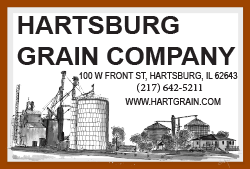|
 Trucking is a key part of
the agricultural industry and yet there are times when it appears to
be a dying industry with fewer trucks available and less manpower
with the proper qualifications to get behind the wheel of a big rig. Trucking is a key part of
the agricultural industry and yet there are times when it appears to
be a dying industry with fewer trucks available and less manpower
with the proper qualifications to get behind the wheel of a big rig.
While the industry is shrinking in regard to trucks and drivers, the
need is still growing as modern advances produce more bushels and
more loads to haul from higher yielding fields.
According to a report published in 2016 by the United States
Department of Agriculture, trucking accounts for “61 percent of the
total modes of transportation in domestic movement of grains.” This
includes delivery from elevators to processors and also what the
UDSA terms as “gathering” tonnage – the amount of grain hauled from
the field to the elevator or storage bins by local farmers.
Heartland Community College Director of Continuing Education
Outreach & Professional Development, Angie Coughlin, agrees that the
availability of truck drivers is shrinking. She noted recently that,
“According to the Bureau of Labor Statistics the demand for truck
drivers will increase 2% between 2020 and 2029. According to the
American Trucking Association in 2018 the shortage of truck drivers
was 60,800.” With the increase in demand across all industries for
truckers and the decrease in supply, the gap is going to be widening
over the next ten years if there is not a shift somewhere.

Locally, grain haulers play an important role in our community as
harvest especially brings on the need for more drivers and more
trucks. But grain haulers are in demand at other times of the year
as well. While harvest is when most people notice corn and soybeans
in trucks on the highway, on a daily basis elevators and terminals
throughout the Midwest are shipping grain with three basic modes of
transportation - truck, rail and barge. Of the three modes, trucking
is by far the most used.
In 2016, an estimated 300 million tons of corn was shipped domestic
in the United States. Of this tonnage, 50 million tons was shipped
by rail, less than 10 million tons were shipped by barge and the
balance, about 240 million tons, was shipped by truck.
While the national statistic indicates that there is very little
barge transportation overall, in this region it is a popular form of
transporting grain. This year in particular, there will be a gap
created by the closure of the Illinois River to barge traffic.
Locally this impacts the terminal in Havana where barges are loaded
and floated downriver to the Mississippi. Trucking and rail will
have to make up that difference, thus increasing the demand yet
again for trucks and truckers.
So, why are we experiencing a shortage of drivers? According to an
article published by Diesel Driving School (truck-school.com) the
top reason for the reduction is drivers are aging out and young
people are not getting behind the wheel to make driving a career.
This is one of the downsides of higher education. While we are
producing more highly educated individuals, we are decreasing the
supply of skilled workers, those who are the physical backbone of
our economy.

Heartland Community College offers a truck driver training class for
those seeking a CDL or Commercial Driver’s License. Coughlin noted
that the average age of the class graduate is 40 years old,
supporting the theory that young people are not pursuing a career in
driving.
Coughlin spent some time recently explaining the program. Now five
years strong at HCC, the truck driver school graduates an average of
40 students per year. The next class to be offered at the Lincoln
campus will take place in January. Coughlin explained the process
for prospective students.
“The Truck Driver Training Program runs approximately four weeks for
the daytime class and eight weeks for the evening class. To get
behind the wheel as a CDL student driver, an individual must pass
the permit test at the Department of Motor Vehicles, as well as have
a certified copy of their birth certificate, and current driver’s
license. In addition, drivers must “pass” the Department of
Transportation (DOT) physical and drug screen, and have a DOT
medical card issued by a nationally-certified medical examiner.
“We are in the classroom for a full week, which equals 40 hours
during which we cover Illinois Secretary of State and Federal Motor
Carrier Safety Administration (FMCSA) safety rules and requirements.
Successful completion of the classroom portion results in earning a
CDL Class A driver’s permit and a grade of at least 80% on
activities, quizzes and final exam.
And, of course, coronavirus is having an impact on this type of
education, just as it is other types. Coughlin explained the covid
approach to ‘in the truck’ training for students. “In accordance
with Heartland Community College’s Standard of Care in response to
Covid-19, our current behind-the-wheel training offers up to 64
hours behind the wheel for an individual sharing the cab with
another student, since we can have up to two students in our cab
with an instructor. Behind-the-wheel sessions last four hours per
day, so students learn by both driving and observing.”
[to top of second column] |

Once graduated, students have
the potential to acquire a Class A commercial driver’s license. This
will enable drivers to operate vehicles with a Gross Vehicle Weight
Rating (GVWR) of 26,001 pounds or more. They also can drive standard
Class B, C, and D vehicles.
What this does for the student and for the farm is enable the driver
to do more than haul grain from the field to the elevator. According
to Truck Freighter (truckfreighter.com) there are occasions when a
vehicle on the farm may be driven without a CDL. “Many farmers and
their families are not knowledgeable of the fact if they need a
commercial driver’s license to drive a farm semi-truck. Most of them
will rejoice the information that they don’t need a CDL to drive a
farm semi-truck.
“Drivers of farm semi-trucks are referred to as a farm vehicle
driver under the law. However, there is a limitation for the length
of driving. The rules are set out by the Department of
Transportation, but individual states may have slightly varying
laws.
“The general rule is farmers can drive a semi-truck up to 150 air
miles away from the farm without a commercial driver’s license.
However, if the 150-mile radius means you’ll have to travel across
the state border, then you’ll need a commercial driver’s license and
the same rules that apply to truck drivers will apply to your farm
tractor-trailer. The reason behind this rule is the notion of
interstate commerce. That is why farmers cannot sell transport
services of their semi-trucks to the public or even other farmers
for that matter.
“Furthermore, the semi-truck-trailer must be driven by a farm
member, worker on the farm, or a member of the farmer’s family.”
The CDL opens the doors for a driver to become his or her own agent,
hiring out to a variety of companies for a variety of jobs.
Investing in a vehicle then becomes more attractive for the CDL
holder because he or she can negotiate rates, set the parameter of
the trips they will do and choose what types of freight they will
transport.

This is good for the farm because the driver as an independent agent
with his or her own truck is contracted and is not officially an
employee of the farm. This saves dollars for the farm by eliminating
wage and fringe, insurances and other expenses directly related to
the driver as an employee.
Heartland is proud of the success they have seen in the driving
school. Coughlin said, “While Heartland does not track where our
students go after completing our program, many of them stay in touch
with instructors. On a regular basis, former students send photos of
their trucks and share updates on how they are doing. HCC is happy
when students go into the workforce with their CDL in hand.”
Trucking companies will also benefit from the increased number of
drivers in the area. With drivers aging out, as mentioned earlier,
there is going to be a demand for younger drivers who are willing to
work in a variety of conditions. Those same trucking companies will
also benefit from the increased need for grain haulers locally.
Tying the two together – new drivers and new business – will be good
for the overall economy in Logan County.
“The successes we most enjoy are when students get hired by driving
companies with a good reputation. When students tell us they are
both earning more and are enjoying where they work, we couldn’t be
happier,” Coughlin concluded.
So the bottom line is: Is there a shortage of drivers – yes. Is it
being addressed locally – yes. For the ag industry the knowledge
that trucking is still going strong in Logan County and there is
potential for future drivers on the horizon has to be a good thing.
[Nila Smith]

|